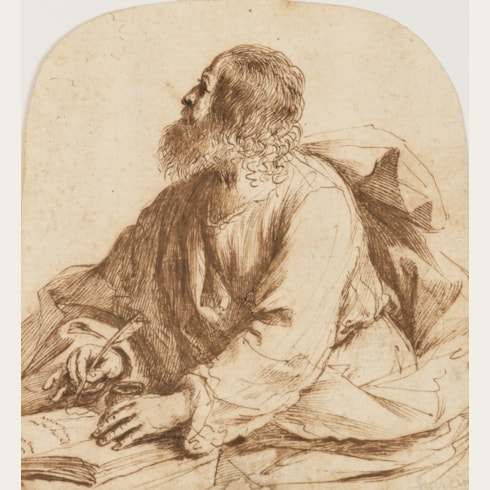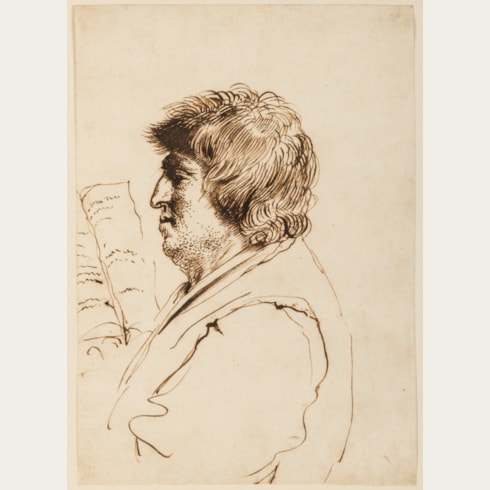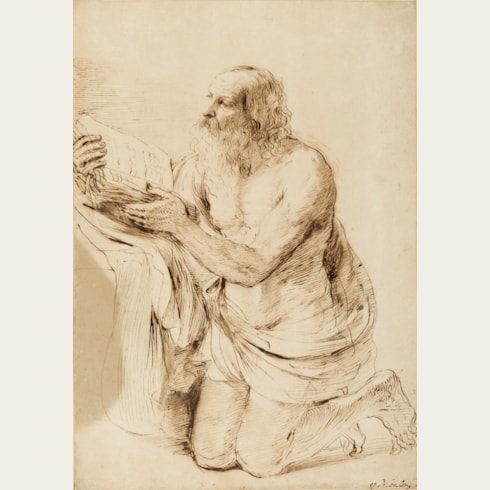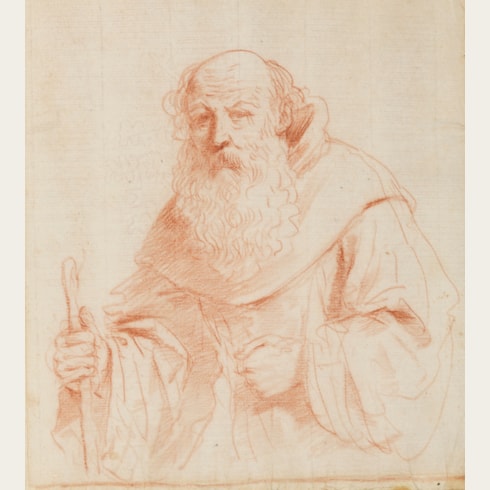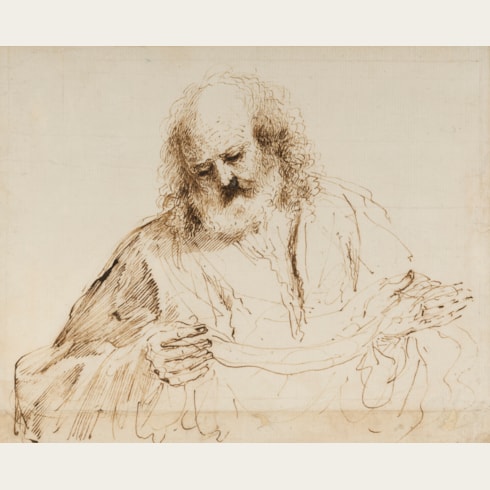Giovanni Francesco Barbieri GUERCINO
(Cento 1591 - Bologna 1666)
The Head of a Bearded Soldier in a Plumed Helmet
267 x 215 mm. (10 1/2 x 8 1/2 in.)
Another possible identification of the subject would be the Circassian warrior Argantes, the fiercest of the pagan knights from Torquato Tasso’s epic poem Gerusalemme liberata, of whom Guercino produced a finished pen and wash drawing and a related painting of c.1645, known in two versions; one in the Uffizi in Florence and the other in a private collection. As Nicholas Turner has noted, ‘Argantes is generally identified by the adundant plumes of his helmet, sometimes construed as a metaphor for his unrestrained ferocity.’ However, it may be noted that the face of the subject in this drawing bears little trace of the aggressive character attributed to Argantes.
Drawings executed almost entirely with the brush, with only a limited use of the pen, are quite rare in Guercino’s oeuvre. Among stylistically comparable examples is a Bust of a Bearded Man in the Rijksmuseum in Amsterdam and a brush drawing of A Warrior with a Plumed Helmet in Profile to the Right in a private British collection. Two further drawings of this type are a study of a soldier with a sword in the Courtauld Gallery in London, which is related to a figure in Guercino’s Hersilia Intervening Between Romulus and Tatius of 1645 in the Louvre, and a drawing of a Mucius Scaevolain the Princeton University Art Museum, which is a study for a painting of Mucius Scaevola Before Lars Porsenna of c.1645-1648, now in the Palazzo Durazzo-Pallavicini in Genoa.
Drawings such as this may have been made to serve as stock figure types and models, to be kept in the studio and used as needed for staffage in paintings or engravings. A very similar frontal view of a man in a plumed helmet, but drawn in red chalk, appeared at auction in New York in 1998 and was formerly in a private collection in Chicago.
The present sheet is part of a small but choice group of Guercino drawings acquired by the soldier, politician and collector Sir Charles Greville (1762-1832), although it remains unclear how, when and from whom he acquired them. Greville’s collection passed by descent to his nephew, George Guy Greville, 4th Earl of Warwick (1818-1893) and was kept at Warwick Castle, on the River Avon in Warwickshire. A dozen Guercino drawings from the Warwick Castle collection are today in the Pierpont Morgan Library in New York.
Giovanni Francesco Barbieri, known as Il Guercino (‘the squinter’) because he was cross-eyed, was by the second decade of the 17th century one of the leading painters in the province of Emilia. Born in Cento, a small town between Bologna and Ferrara, Guercino was largely self-taught, although his early work was strongly influenced by the paintings of Ludovico Carracci. In 1617 he was summoned to Bologna by Alessandro Ludovisi, the Cardinal Archbishop of Bologna, and there painted a number of important altarpieces, typified by the Saint William Receiving the Monastic Habit, painted in 1620 and now in the Pinacoteca Nazionale in Bologna. When Ludovisi was elected Pope Gregory XV in 1621, Guercino was summoned to Rome to work for the pontiff and his nephew, Cardinal Ludovico Ludovisi. It was in Rome that Guercino painted some of his most celebrated works, notably the ceiling fresco of Aurora in the Casino Ludovisi and the large altarpiece of The Burial and Reception into Heaven of Saint Petronilla for an altar in Saint Peter’s. The papacy of Gregory XV was short-lived, however, and on the death of the Pope in 1623 Guercino returned to his native Cento. He remained working in Cento for twenty years, though he continued to receive commissions from patrons throughout Italy and beyond, and turned down offers of employment at the royal courts in London and Paris. Following the death of Guido Reni in 1642, Guercino moved his studio to Bologna, where he received commissions for religious pictures of the sort that Reni had specialized in, and soon inherited his position as the leading painter in the city.
Guercino was among the most prolific draughtsmen of the 17th century in Italy, and his preferred medium was pen and brown ink, although he also worked in red chalk, black chalk, and charcoal. He appears to have assiduously kept his drawings throughout his long career, and to have only parted with a few of them. Indeed, more drawings by him survive today than by any other Italian artist of the period. On his death in 1666 all of the numerous surviving sheets in his studio passed to his nephews and heirs, the painters Benedetto and Cesare Gennari, known as the ‘Casa Gennari’.
The drawings of Guercino, which include figural and compositional studies, landscapes, caricatures and genre scenes, have always been coveted by later collectors and connoisseurs. Indeed, the 18th century amateur Pierre-Jean Mariette noted of the artist that ‘Ce peintre a outre cela une plume tout-à-faite séduisante’. The largest extant group of drawings by Guercino is today in the Royal Collection at Windsor Castle; these were acquired from the Gennari family by King George III’s librarian, Richard Dalton, between about 1758 and 1764.
Provenance
By descent to his nephew, George Guy Greville, 4th Earl of Warwick, Warwick Castle, Warwick (Lugt 2600)
Thence by descent at Warwick Castle
Probably the Warwick sale (‘The Rare and Valuable Collection of Drawings by Old Masters of the Right Hon. The Earl of Warwick, Deceased’), London, Christie’s, 20-21 May 1896, part of lot 174 (‘Study of a Young Soldier – black chalk; and two others’, bt. Richter)
Dr. Jean-Paul Richter, London
His sale (‘Vente importante de dessins anciens provenant e.a. des collections J. P. Heseltine et Dr. J. Paul Richter de Londres’), Amsterdam, Frederik Muller & Cie, 27-28 May 1913, lot 315 (‘Tête de guerrier. Vue de face et coiffée d’une casque à grand panache. Plume et lavis de bistre. – Haut. 27, larg. 23.1 cent. Collections Clerke et Earl of Warwick 1896.’)
Private collection, France.





















